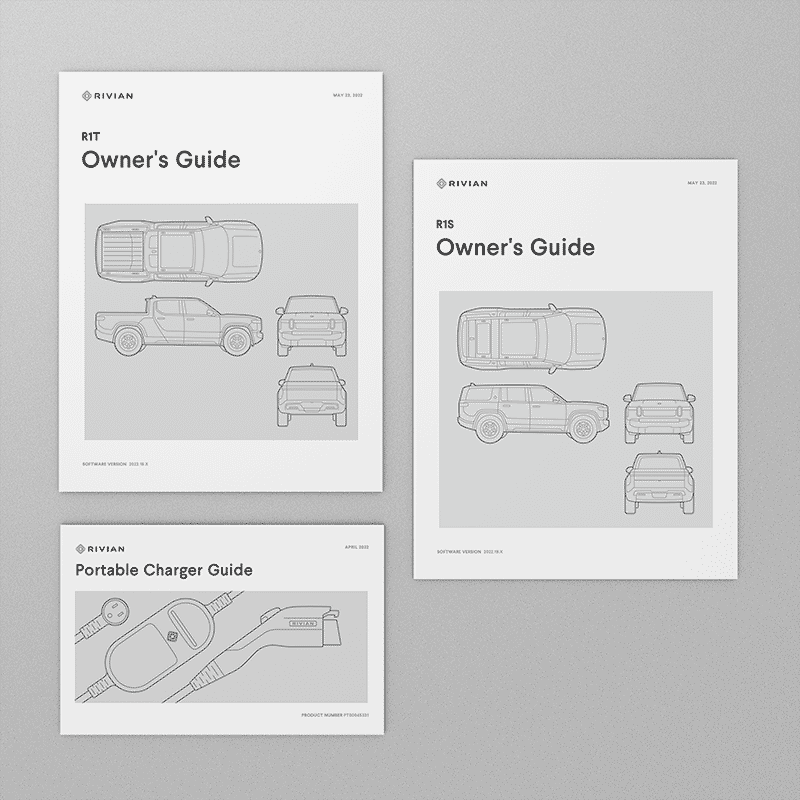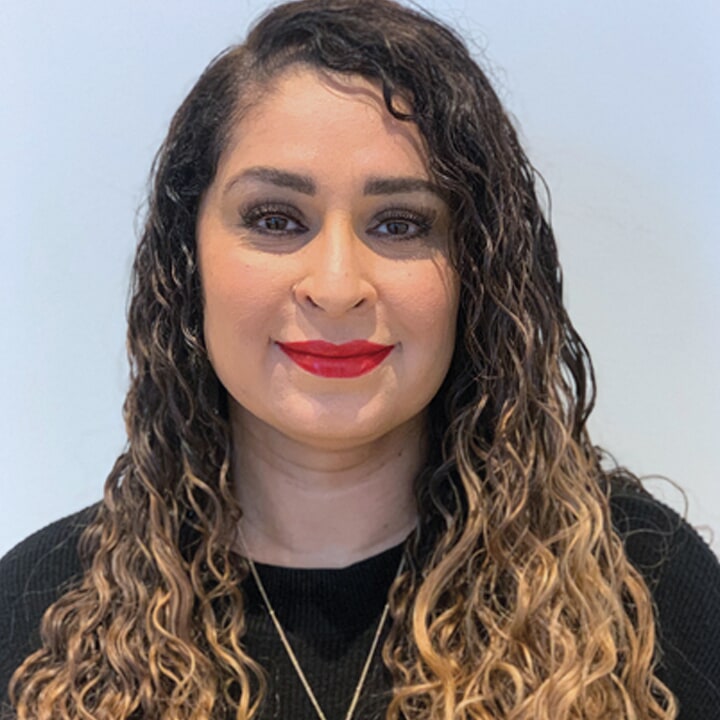Customer Success Story
Rivian Uses MadCap Software to Embed Interactive Owner’s Guide in Vehicle’s Infotainment Dashboard
Optimized User Experience
Streamlined Content Delivery
Enhanced Consistency
Quality Assurance
Customer Success Story
Optimized User Experience
Streamlined Content Delivery
Enhanced Consistency
Quality Assurance
The interactive, in-dash vehicle guide we’ve created with Flare is integral to creating a superior experience for our customers.
David Jackson Director, Technical Publications, Rivian
Whether it’s taking families on new adventures or helping fleets electrify at scale, Rivian is committed to building electric vehicles that preserve the natural world for generations to come. In late 2021, the company began delivering its first two vehicles: the R1T truck and R1S sport utility vehicle (SUV), both designed for off-road adventures. Rivian has also announced plans to roll out electric delivery vans, along with enterprise software to manage fleets and networks of its electric vehicle chargers.
Rivian’s electric vehicles are seeing high demand, including more than 90,000 pre-orders for the R1 models, alone. To help drivers and future fleet managers utilize all the features of its electric vehicles, Rivian has focused on producing product guides and documentation that are as modern and efficient as their automotive solutions. These include owner’s guides that are integrated into the vehicle infotainment system, web-based documentation for the enterprise fleet software, and printed guides for additional products within the Rivian ecosystem, like vehicle chargers and accessories.
Today, Rivian delivers its guides and documentation using the MadCap Authoring Management System (AMS), which offers a complete solution supporting the entire content development lifecycle. MadCap AMS capabilities include MadCap Flare for single-source authoring and publishing and MadCap Flare Online for cloud-based content collaboration, project management, analytics, and more.
As a new automotive company, Rivian has had an opportunity to build modern product documentation from the ground up. Therefore, in selecting a solution for creating and publishing this content, the company had several requirements, both in terms of the user experiences and the flexibility and reuse it would provide the company’s writers.
“We needed an authoring system that could be implemented quickly,” recalled David Jackson, director, technical publications at Rivian. “Another critical requirement was the ability to output to a variety of file formats. In particular, we wanted our customers to be able to read an owner's guide that blended in with the vehicle’s infotainment system right in the center display.”
Additionally, David noted, “Because our vehicles are designed for off-road use, we knew that they were not always going to have connectivity, so we needed to provide content that was searchable even when the vehicle is out of range from any sort of Internet network.”
Other key requirements were that the authoring system needed to be customizable, as well as strong on content reuse, content storage, and translation management.
Rivian began reviewing advanced content authoring and publishing solutions and quickly narrowed the search in its evaluation of vendors that could provide a comprehensive suite of components that all worked together.
“MadCap AMS met all of our requirements and simplified the implementation process. We also determined that the HTML5 output could be used to create an excellent in-vehicle guide,” David said. “In that way, AMS met two of the biggest requirements that we had.”
All of Rivian’s product documentation is now created using the MadCap Flare authoring software within MadCap AMS. In addition to the digital in-vehicle owner’s guides, this includes documentation covering Rivian’s chargers, accessory products, and enterprise software system.
“The interactive, in-vehicle Owner’s Guide we’ve created with Flare is integral to creating a superior experience for our customers,” David notes. To these users, the guide appears to be one more application in the infotainment center, right along other apps, such as music, phone and navigation. By pressing the icon to get to a menu of topics and the search bar, customers can quickly get to the vehicle information they need. Additionally, because the guide is HTLM5 output that resides locally, drivers can access it even when they are off-road and away from Internet access.
Fill Out the Form to Start Your Free 30-Day Trial
“The interactive, in-vehicle Owner’s Guide we’ve created with Flare is integral to creating a superior experience for our customers,” David notes. To these users, the guide appears to be one more application in the infotainment center, right along other apps, such as music, phone and navigation. By pressing the icon to get to a menu of topics and the search bar, customers can quickly get to the vehicle information they need. Additionally, because the guide is HTLM5 output that resides locally, drivers can access it even when they are off-road and away from Internet access.
Built using MadCap Flare, the Rivian owner’s guide can be easily accessed by drivers even when they are off-road and away from Internet access.
“Much of our work was focused on fine-tuning the design of our vehicle guide to integrate it within the overall software system,” David explained. “We moved pretty quickly to proof of concept and didn’t face any big technical roadblocks in running HTML5 output in our vehicles. That is because of the open, standards-based architecture of Flare.”
One of the biggest requirements for each vehicle guide is to automatically switch between day and night mode along with the rest of the infotainment system. To address this challenge, the Rivian documentation team has used a combination of scalable vector graphics (SVG) and cascading style sheet (CSS) conditions in MadCap Flare to produce images and text that are customized for day mode and night mode.
With Flare, we were able to develop an implementation that made it possible to switch between day and night modes for our vehicle guide and optimize the customer viewing experience.
Hennah Rahman Senior Staff Production Manager, Rivian
Another critical requirement is ensuring that updates to the interactive vehicle guide keep pace with the updates that Rivian regularly makes to the software in its vehicles via over-the-air updates, so customers have up-to-date information.
David explains, “Flare’s flexible publishing capabilities have enabled us to deliver over-the-air vehicle guide updates seamlessly alongside vehicle software updates.”
MadCap Flare’s flexible publishing capabilities have enabled Rivian to deliver over-the-air vehicle guide updates seamlessly alongside vehicle software updates.
The documentation team continually seeks new ways to help customers find the information they need faster. To understand how successfully these users are navigating the interactive in-vehicle guide, the team relies on the analytics capabilities of MadCap Flare Online.
For example, Rivian refers to the storage compartment in front of the passenger as the front trunk, but MadCap Flare Online identified the fact that some customers search using a popular term with electric vehicle owners, “frunk.” With that insight, the documentation team was able to create a synonym in MadCap Flare, so if someone searches for “frunk,” the guide shows topics that use the term, “front trunk,” enabling the user to find the right topic.
In addition to using MadCap Flare Online for its analytics and source control, Rivian also takes advantage of it for testing and publishing content. These processes have been particularly valuable in speeding the delivery of the in-vehicle guide. By publishing HTML5-based content to MadCap Flare Online, the team can review and preview what the documentation will look like online and ensure that changes have been captured correctly—essentially providing a means of quality assurance before putting content into a software build.
Once testing is complete, the documentation team uses MadCap Flare Online to set up a destination target on Amazon Simple Storage Service (Amazon S3) and push the HTML5-based documentation to a bucket from which the development team can easily pull the guide.
“Testing lets us catch things quickly and fix them before the development team does the work of integrating the guide into the software,” David notes. “Then the ability to just save credentials for an Amazon S3 bucket and hit publish in MadCap Flare Online each time we're ready to hand off content provides a level of automation that significantly speeds up the publishing process,” David continues.
Rivian now produces some 40 documents using MadCap AMS. In addition to the infotainment owner’s guides for each electric vehicle model, this includes documentation covering Rivian’s chargers, accessory products, and enterprise software system. These are delivered as HTML5-based online content, digital PDFs that can be downloaded at rivian.com, and printed guides that are included with Rivian’s vehicles, charging products, and accessories.
Rivian now produces some 40 documents using MadCap AMS, including documentation covering Rivian’s chargers, accessory products, and enterprise software system.
“The designs of our documentation are very specific to the needs of our users. For example, the in-vehicle guide has an infotainment touchscreen with relatively large buttons and a scrollable table of contents while we use a more conventional online Help system design for our enterprise software system,” David says. “The design capabilities in Flare are flexible enough that we can produce optimized content for both touchscreen and computer use, depending on the document that we were creating.”
The documentation team also makes extensive use of MadCap Flare’s topic-based authoring, conditions and variables to maximize content reuse since many of the features in its R1T truck and R1S SUV are the same or similar. Additionally, the team uses a global project in Flare, which holds all of the shared templates, conditions, style sheets, and any other topics or content that they want to reuse. Not only does this streamline projects; it also ensures consistency across the documentation.
“We have copyright and customer service content that needs to be the same wherever it appears,” Hennah explains. “Using the global project in Flare is a really good way to make sure that we collaborate and maintain consistency with the same look, feel and voice across all the content that we’re producing.”
Hennah adds, “The fact that we can use MadCap Flare to produce our own content, and that we can own that process from start to finish gives us a lot of flexibility and substantially increases our speed to deliver content. We continue to explore new ways we can use Flare to increase our efficiency and enhance the experiences of our customers.”
Presented By:
Hennah Rahman





